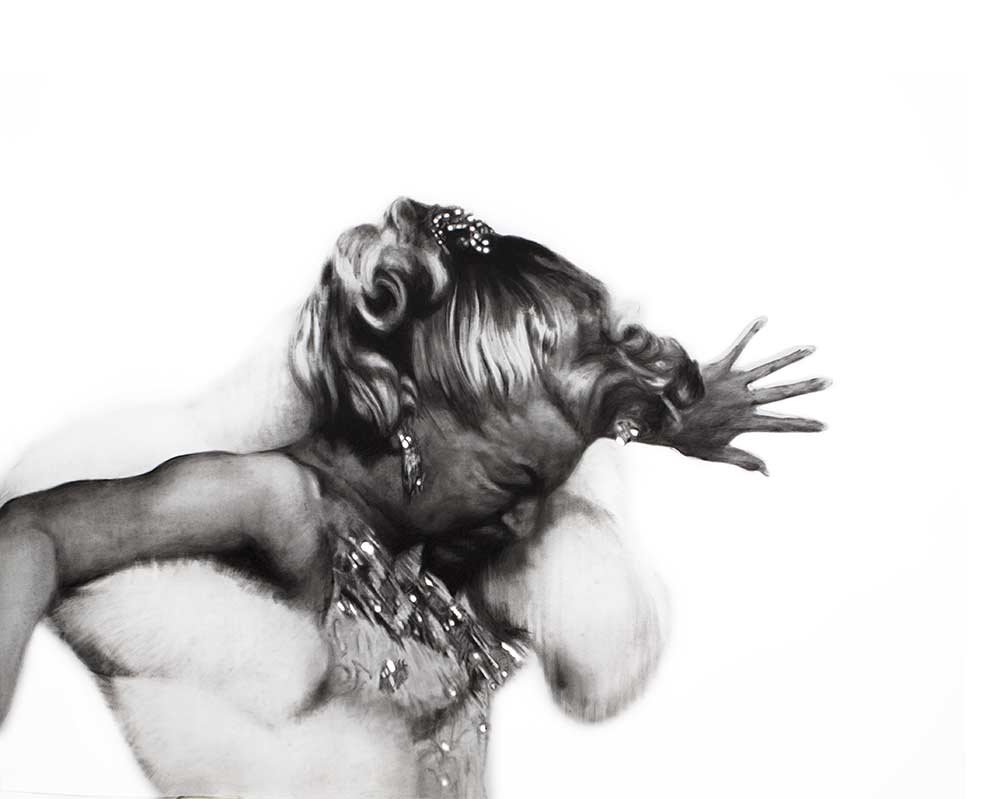Elegant Archetypes: Feminism and the Icon in Wild Ride
Charlotte Martin
Contemporary Art Theorist
Featured in Measuring Elvis, 2015
I have been to lots of parties
and acted perfectly disgracefully
but I never actually collapsed
oh Lana Turner we love you get up
Frank O’Hara [1]
Intrigued by the emotional excessiveness of a scene from The Bad and the Beautiful [2] in which a distraught and hysterical Lana Turner flees in a car from a lover who has just betrayed her, Fowler started to work. It is her process here that deserves particular attention. Fowler takes every frame of the scene and watches them through incessantly, taking note of minute differences, rewinding, skipping forward, eventually stitching together her own vision of Turner; a potent and immediately arresting one. In the compositions of Wild Ride and Wild Ride II, Fowler strips out the car interior leaving a manic Lana Turner surrounded by stark white space, sparkling and rolling around the drawing. There is an ambiguity to Turner’s posture: is she falling, drunk or dancing? Yet through this ambiguity erupts an overwhelming sense of emotion, one which is immediately recognisable to the spectator.
Fowler’s practice is one of evocation: the evocation of grief, misery, female experience, gender delineation, desire, sex, the icon and other innate concepts that reside in our sense of social being. Her chosen tool for sharing these ideas with the viewer is that of the elegant archetype. Archetypes form the basis of the psychoanalyst Carl Gustav Jung’s theory of human understanding. For Jung, archetypes are archaic, universal patterns, lurking in what he referred to as the collective unconscious. Once actualised in the individual’s conscious, the recognition of such patterns is immediate, due to the instinctual and collective nature of their representation. Fowler’s archetype operates on many levels, its instantaneous impact on the viewer gradually giving way to more complicated themes.
Inherent to Fowler’s elegant archetype is her feminism. Her feminism is neither a mere recapitulation of the latest academic trends, nor essentialism. It is, rather, an ideological position. Ideology as gathered through the artist’s own lived experience and the lived experiences of women around her, including stars like Lana Turner. Depicting these icons through her lens, she highlights the aspects of female experience that are universal. The female icons that fascinate Fowler and the public are the ones who gently interrupt the societal expectations of their gender; Fowler’s work explores the impact of such interruptions on both these icons and contemporary women in general.
Fowler lives these politics through the work she creates and the way in which she works. The sheer size of her drawings can be read as a protest against the male-dominated art world. Their scale acts as a visual channel of this frustration and desire for change. Fowler’s chosen practice of drawing is yet another form of protest: a medium traditionally considered preparatory, not yet the finished form or worthy of any great status in itself. Here Fowler boldly holds up drawing as a finished work of art, displaying its outcomes in ornate frames. For her, drawing is not something to be subjugated and her monochrome optic quietly disrupts a conventionalised, male art world.
It is this practice of quiet disruption that exists throughout Fowler’s oeuvre; disruption of tradition, disruption of icons, disruption of myth, disruption of modes of working. It’s this that makes her work so compelling and always more complex than it may first appear.
FOOTNOTES
[1] Excerpt of Poem (Lana Turner has collapsed!) from Frank O’Hara, Lunch Poems, City Lights Books, 1964.
[2] The Bad and the Beautiful, 1952 — Hollywood’s film about Hollywood, sees Lana Turner playing a character with stark similarities to the actress’s own off-screen life. The film discusses Hollywood’s façade of hypocrisy right from the opening scene, where Kirk Douglas’s character is paying mourners to cry at his father’s funeral (a famous producer).
